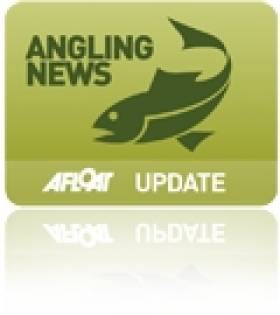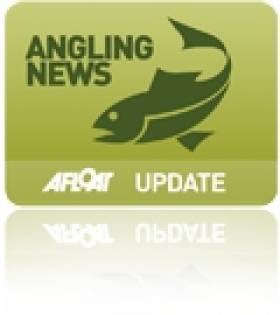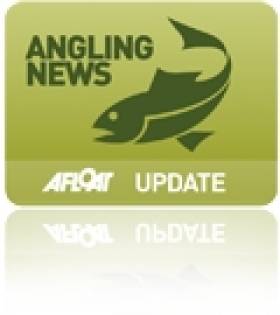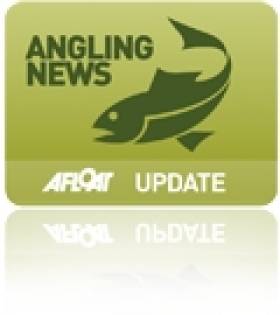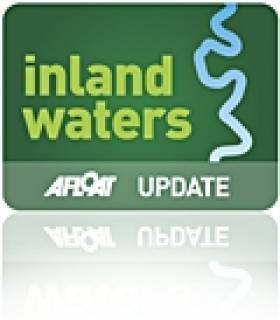Displaying items by tag: trout
New Salmon & Sea Trout Bylaw for River Suir
#Angling - Recreational angling on the River Suir is set for a change as a new bylaw sought by a majority of anglers has been signed into law.
As of Friday 12 April till the end of the season, when fishing for salmon and sea trout (over 40cm) on the River Suir, the use of worms, prawn, shrimp or any other crustacean or artificial forms thereof as bait is prohibited - as is the use of any fish hooks other than single barbless hooks, up to and including 11 May.
From 12 May to 30 September the bylaw provides for a bag limit of five fish for the season subject to a daily bag limit of one fish. Anglers must use a single barbless hook once their daily or season bag limit has been reached.
Inland Fisheries Ireland (IFI) points out that this bylaw is applicable to the 2013 season only.
It is hoped that this measure will ensure even better angling for the many local anglers and angling tourists that come to fish the Suir for brown trout from Tipperary to Waterford.
Young Dublin Angler Catches Record Trout At Lough Ramor
#Angling - A new record has been set by the Dublin Angling Initiative with 16-year-old Eric Cahill catching a fish of a lifetime - a 12lb ferox trout from Lough Ramor in Virginia, Co Cavan.
This is the biggest fish ever caught by a youngster out angling with the Dublin Angling Initiative (DAI).
The fishing trip for a group of 10 young anglers was organised for Mulhuddart Foróige Fishing to Lough Ramor by Des Chew of the DAI in March.
Following an introduction by Des on the setting up of rods, rigs and bait presentation, the youngsters were soon fishing for roach, hybrids and perch with others choosing to fish for pike.
Great fun was being had by the group who were catching and releasing lots of coarse fish.
Meanwhile, Eric patiently waited for a pike to take his smelt deadbait. He signalled for assistance when his rod tip nodded indicating a take. Under the guidance of Des Chew and Chris McGregor, he was instructed to knock his bale arm over so this cagey fish would feel no resistance.
Suddenly there was a short run and Eric struck. It was obvious he had a big fish on. When the fish drew close, the golden-spotted body revealed that Eric was now playing a fish of a lifetime and maybe the first specimen caught by a DAI angler.
The fish was landed amid great excitement by the kids, youth workers and a crowd of local anglers alike.
Before release it was weighed on certified scales, and laid out and measured on an Inland Fisheries Ireland measuring mat. It reached a length of over 80cm and weighed in at over 12 lbs.
There was jubilation among Eric and his peers as Des announced that he had just caught the first specimen from over 10,000 teenagers who have participated in DAI courses over the last 15 years.
If this fish is ratified by the Irish Specimen Fish Committee it will also be the first specimen recorded from Lough Ramor.
Eric Cahill has been a member of Mulhuddart Foróige Fishing in west Dublin since he has been 10 years of age. During that time the DAI says he has always shown unique ability to listen and learn angling skills from his tutors.
He has attended numerous fishing courses in game, coarse and sea fishing run by the DAI with his Foróige youth officers, Bernie Moloney and Siobhan Hennessy.
According to Inland Fisheries Ireland, this was truly a very proud moment for Eric and the Dublin Angling Initiative, whose members now have a new record to beat!
New Bylaws for Salmon and Trout Angling
#Angling - Six new bylaws of relevance to the angling community and the commercial fishing industry have been signed into law this week by Minister of State Fergus O'Dowd.
The Conservation of Sea Trout Bye-Law provides for a daily bag limit of three sea trout (less than 40cm in length and provides for the use of single barbless hooks and prohibits the use of worms as bait once the specified number of sea trout has been caught.
The Prohibition of Angling Methods Bye-Law prohibits the use of any fish hooks, other than single barbless hooks, and also prohibits the use of worms as bait in angling for all species of fish in the waterways specified.
The Conservation of Salmon and Sea Trout (Newport River) Bye-Law provides for catch and release in respect of Salmon and Sea Trout (over 40 cm) in the Newport River including the waters of Lough Beltra and the Crumpaun River, Co Mayo during the period 20 March to 11 May 2013.
The Conservation of Salmon and Sea Trout (River Nore) Bye-Law provides for catch and release in respect of Salmon and Sea Trout (over 40 cm) in the River Nore during the period 17 March to 11 May 2013.
The Conservation of Salmon and Sea Trout (River Slaney) Bye-Law extends the annual close season in angling for salmon, sea trout and brown trout in the River Slaney and its tributaries in the year 2013 from 26 February to 16 March and from 17 September to 30 September. The bylaw provides for catch and release during the period 17 March to 16 September in angling for salmon and sea trout. It also provides for the use of artificial fly only with single barbless hook upstream of the Old Bridge in Enniscorthy, and provides for single barbless hook and a ban on worms as bait downstream of the bridge when angling for salmon or sea trout.
Finally, the Draft Nets and Snap Nets Bye-Law sets out the opening and closing dates (and hours) for the draft net and snap net salmon and sea trout (salmon includes sea trout as defined in the Inland Fisheries Act 2010) commercial fishing season 2013 and prohibits draft net and snap net fishing for (salmon and sea trout) in all fishery districts except those mentioned in the schedule. It also prohibits the use of monofilament material in draft nets, with the exception of Cork Harbour and Castlemaine Harbour where monofilament material in draft nets is permitted.
#ANGLING - Welsh angler Ceri Jones couldn't believe his luck when he fished a record-breaking monster trout from Lough Corrib last weekend.
According to The Connacht Telegraph, Jones hooked the 24lb goliath near the lake's biggest island Inishgoll on Saturday 26 May.
And if declared an authentic specimen by the Irish Specimen Trout Committee, it will rank as the largest trout caught in Ireland since 1894, when William Mears landed a 26lb brown trout at Lough Ennell.
Jones, a freelance photographer with Trout Fisherman magazine, said: “When I hooked it first, I knew instantly it was big fish. It was like hooking a car, the line just streamed off the reel.
“Using this type of big bait, you're either going to get nothing or a big fish,” he added, referring to the roach deadbeat he used to troll the trout for over an hour.
The Welshman plans to have his prize stuffed and mounted in Burke's Bar in Clonbur, Co Galway.
The Connacht Telegraph has more on the story HERE.
Hooked Live! Returns to CityWest This Weekend
#ANGLING - Hooked Live!, Ireland’s premier angling and fishing show, is returning to the CityWest Hotel and Lakes this weekend 10-11 March for the third year running.
Spey caster and innovator Ian Gordon is the latest star to join the already confirmed visitor favorites Paul Young, Henry Gilbey, Scott MacKenzie, Andrew Ryan and AGPAI Ireland, who will bring world-class casting demonstrations, talks and personal one-to-one sessions designed to improve and empower visitors to become better anglers.
Bringing the best in Irish angling water sports, with new tackle, venues and angling techniques, Hooked Live! also caters for the fly-fishing enthusiast with fly-tying and casting lessons.
And that's not to mention fly-fishing on our fully stocked lake, where both trout and perch will readily take a fly. Indeed, there are many top prizes to be won in the Lakes Fishing Challenge.
Sea anglers are also catered for and welcome at Hooked Live! and for the coarse fisher, there will be top class exhibits with great tackle and equipment available and a range of venues which will produce results.
Popular seminars will also cover some of the new and successful tackle and techniques which are now being used to catch more fish.
Also returning to Hooked Live! will be the Sporting Gun Show. Taking advantage of the synergy between shooting and fishing, visitors will be able to pick up bargains on end-of-shooting-season stock.
Tickets for Hooked Live! 2012 are priced from just €10 and are available now from tickets.ie. For more details visit the official website at www.hooked.ie
New Angling Guide for Lough O'Flynn and Upper Suck
#INLAND WATERWAYS - Inland Fisheries Ireland (IFI) officially launched the Lough O’Flynn and Upper Suck Angling Guide at the Old Stonehouse Restaurant in Ballinlough recently.
The guide opens to Lough O'Flynn, a 300-acre limestone lake situated 2km from Ballinlough and one of IFI’s many managed lakes requiring a permit.
This lake holds a stock of wild brown trout and is also stocked with brown trout each year which provides an excellent opportunity for all kinds of anglers and those wishing to take up the sport to learn how to fish for trout.
Meanwhile, the centrefold of the guide showcases the Upper Suck catchment from Lough O’Flynn through Co Roscommon and Galway until the Shiven tributary joins, along which good quality coarse, pike and trout angling can be expected.
With breathtaking scenery, this is the perfect place for anglers who can fish almost undisturbed from dawn till dusk.
There are also a considerable number of sections dedicated to anglers with disabilities, such as the Donamon angling stretch which has 30 fishing stands available with individual car parking bays and toilet facilities. This section has proven extremely popular, and IFI says it is committed to ensuring that sections like Donamon continue to open fishing up for everyone.
Amanda Mooney, director at IFI, said: “The guide offers a great source of information on angling hotspots for various types of species, access points and facilities, legislation and safety.
"All in all everything you need for planning a fishing trip. The guide and angling promotion in general supports local businesses and communities in sustaining jobs.”
The Lough O’Flynn and Upper Suck Angling Guide is available from IFI outlets and local permit agents in Ballinlough, Co Roscommon.
Inland Fisheries Ireland also marked the retirement of John Ryan, assistant inspector for Lough O’Flynn and the Suck catchment, after 41 years of service.
Ryan was involved in many areas and aspects of fisheries throughout his career, and was particularly noted for his positive engagement with various groups from angling clubs and development associations to local authorities, businesses and communities.
Minister Opens White River Fishery Enhancement Project
#ANGLING - Minister of State Fergus O'Dowd was on hand at the opening of the White River enhancement project in Dunleer, Co Louth earlier this month.
The €32,000 project was funded by the Louth Leader Partnership, with works were carried out by the Dee and Glyde Fishing Development Association and the Dundalk district staff of Inland Fisheries Ireland.
The White River, a tributary of the River Dee, is considered hugely important as a spawning and nursery area, and it has already seen significant improvements in the levels of juvenile salmon and trout.
Instream enhancement works began in 2006, supervised by Inland Fisheries Ireland, and included the introduction of new gravel, weirs, deflectors and spawning beds which have helped the White River to achieve its potential in terms of fish numbers.
Speaking at the launch, Inland Fisheries Ireland CEO Dr Ciaran Byrne said: "The work that I have seen on the river is fantastic and a credit to all involved."
IFI assistant inspector in Dundalk, Ronan O’Brien, said project was based on restoring the natural features of the river.
He added that the programme was a great recognition of the work carried out by the Dee and Glyde Fishing Association, and that it had strengthened links with local business and development groups and could be used as a template for other projects in the area.
Go Fishing in Ireland - an 'Angler's Paradise'
DiscoverIreland guest blogger Kirsten Fruit has posted a quick guide highlighting Ireland's abundance of world-class angling spots.
"For years, fishing fanatics from around the world have found a haven of sorts in Ireland’s waterways," she writes, "and it isn’t hard to see why."
Ireland has it all, from deep-sea angling for bass or cod to trout or salmon fishing on rivers and lakes.
But it's not just for the experts, as there are many excellent angling guides throughout the country who make a business out of introducing newcomers to the sport.
"Having a guide adds 100 percent to an individual’s enjoyment on the river," says Ballynahinch Castle's master ghillie Simon Ashe.
DiscoverIreland has more on the story, including guides' favourite angling spots, HERE.
'Natural Prawn Killers' Pose Threat to Irish Marine Life
Irish boatowners and fishermen on inland waterways have been urged to remain alert to the prospect of so-called 'killer shrimp' invading Ireland's waters.
The dikerogammarus villosus shrimp - which has spread aggressively throughout Europe in the past decade and was discovered in England last year - could have "dire consequences" for the biodiversity of Ireland's rivers and lakes.
Kevin Flannery of Dingle Oceanworld told the Sunday Independent: "These invasive species are very aggressive and take over from the native species - and change the whole environment and ecosystem."
The killer shrimp is larger that its native cousin, making it a more deadly predator. It is known to attack insect larvae, baby fish and native shrimp.
"The shrimp will eat the primary source of food for the trout and salmon and other indigenous species which have been here for billions of years," said Flannery.
The killer shrimp has spread mainly by attaching to boat hulls at the larval stage, promping Flannery to urge all fishermen and boatowners to disinfect their vessels before using them in Irish waterways.




























